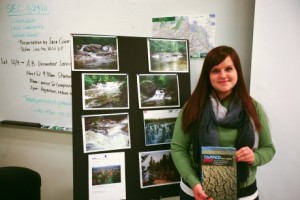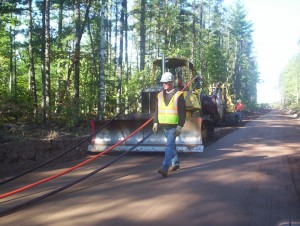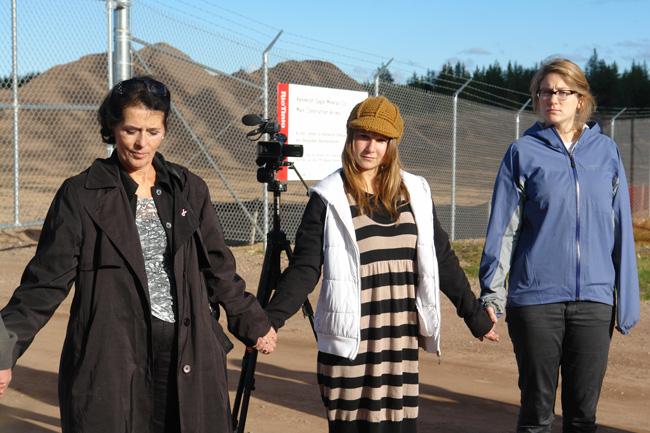by Lillian Marks Heldreth
If anyone is wondering why people continue to protest Kennecott’s Eagle Mine Project, or why litigation is ongoing despite the fact that we are repeatedly told it’s a “done deal,” the reason is simple: the Michigan Department of Environmental Quality (MDEQ) and Kennecott have together managed to circumvent and ignore Michigan’s mining and environmental protection laws as well as applicable federal statutes.
Both Kennecott and the state claim that we are protected by these laws, but because they have chosen not to obey them, the miners, the environment, and our citizens are without any protection whatsoever from what promises to be a disaster, the scope of which ranges from “very bad” to “the BP of the Great Lakes.”
Because to our knowledge the full scope of these violations has never been published in one place in any of the public media, we consider it our civic duty to reveal them here, as clearly and as simply as we can.
OUR SOURCE
Most of our information is drawn from a 100-page brief filed on July 23, 2010 in Washtenaw County Circuit Court. It appeals the Final Determination Order of the MDEQ, which upholds the permit granted to Kennecott Eagle Minerals Company under the provisions of Part 632 of Michigan’s Natural Resources and Environmental Protection Act.
This brief summarizes testimony from all previous litigation in the case, and clearly demonstrates that essential provisions of the law were bypassed while compelling scientific evidence was ignored.
This brief does NOT call for an end to sulfide mining efforts in Michigan. It calls for fair, honest enforcement of Part 632 of our State’s duly instituted mining code and federal codes. It asks that Kennecott’s operation be required to meet the stipulations of Michigan’s laws.
“Kennecott’s proposed Eagle Mine,” the brief charges, “stands poised to combine, here in the Great Lakes System, elements of recent West Virginia and Utah mine disasters with the catastrophe of the Gulf oil spill. As oil is to the waters of the gulf of Mexico, sulfuric acid and heavy metals like nickel, copper and arsenic could be to Lake Superior if, as predicted, the proposed mine or treatment systems fail.”
The brief details how Part 632 of Michigan’s law is expressly designed to minimize the known damaging effects of nonferrous (anything but iron) metallic sulfide mining, which, if not properly controlled, according to the law, “can cause significant damage to the environment, impact human health, and degrade the quality of life of the impacted community.”
NO LEGAL ENVIRONMENTAL ASSESSMENT
Part 632 requires an applying company to provide in advance an Environmental Impact Assessment, with detailed natural resource information for the entire potentially affected area outside the mining area. It must include data on land surface, surface water, ground water, air resources, resident plants, animals, insects, and birds, and must provide benchmarks for evaluating a later dates the mine’s impact in the environment.
Kennecott did not do this study. Instead, during previous litigation, Kennecott persuaded the Administrative Law Judge and the agency effectively to read the word “potential” out of the statute, and to declare that the mining operation would have “no adverse environmental effects outside the fence line.”
Thus, any effects downstream, downwind, or in the surrounding water table or to wildlife outside the fence are effectively eliminated from any need for consideration. –Or, we assume, from cleanup responsibility as well.
If so, that neat bit of finagling must be saving Kennecott millions or billions in potential liability and cleanup costs. But the rest of us can’t drink money.
A FATALLY FLAWED DESIGN
By ignoring 300 safety warnings, officials of Massey Coal, another English Multinational, saved themselves the cost of adequate ventilation systems, effectively killing 28 miners by suffocation and/or methane gas explosion in April, 2010. We’d call that murder, for they were repeatedly warned.
Unfortunately, Kennecott, too, has been warned, and advised by experts whom its agents chose to ignore, to change the design of this mine.
“Kennecott and the agency [MDEQ] have also steadfastly refused to take into account the overwhelming concerns from experts on all sides of the contested case that the proposed mine, as designed, would be unstable and likely to collapse.”
Five experts essentially agreed, even though the data they were given were supplied by Kennecott, and were presumably the most favorable Kennecott had to offer. But the experts knew their subject well, pointing out that Kennecott’s designers had used an outmoded method of calculation, and had not taken into consideration any of the local geologic characteristics, including a great deal of shale in the “crown pillar” (roof of the main shaft), a fault line, an intrusive dike, or any horizontal stress. (We note that shale tends to slide sideways).
Nor had Kennecott’s team accounted for the fact that the crown pillar would be under the Salmon Trout River and would be wet, greatly increasing the chance for slippage and failure.
Part 632 of Michigan’s law specifically requires a contingency plan for the potential of a collapse. Kennecott hasn’t shown one.
DISASTROUS CONSEQUENCES OF COLLAPSE
The consequences of such a collapse are horrific. Jack Parker, a recognized mining engineer and industry consultant, has also testified that the mine is likely to collapse, and that if the crown pillar collapses entirely, the Salmon Trout River would be sucked all the way down into the cavity itself. In another report, Mr. Parker also maintains that because of factors inherent in the faulty design, no workers could escape from the mine alive in the event of collapse or mine fire. Mr. Parker expects that collapse would also likely result in fire.
We can see only one reason for insisting on a plan that mining experts consider to be highly dangerous. It’s quicker and therefore cheaper, which means higher profits, but arguable at a potential cost in human life.
We also note that the recent Chilean mine collapse, which trapped 33 miners underground for several months and cost a tremendous amount in rescue efforts, has been attributed to flaws in the mine’s design, also due to cost-cutting efforts.
ENVIRONMENTAL CONSEQUENCES OF THE MINE’S OPERATION
Here we think it best to quote directly from the brief’s summary. As Kennecott has done no environmental studies, the plaintiffs called reputable scientists to testify in previous hearings. We have deleted specificreferences for readability, but they may be found on our website:
1. Dr. John Ejnik testified that the entire Salmon Trout River will be polluted from the mine at levels that will destroy aquatic life.
2. Dr. David Flaspohler detailed respects in which operations on the immediate physical facility will produce impacts far beyond the property lines or the facility boundary lines:
a. Truck traffic will have an effect on wildlife along the roads.
b. Road dust generated by heavy traffic on an unpaved road will settle into snow, and affect area wildlife after snow melt.
c. The deposition of heavy metals will be spread over tens of kilometers and enter both land and water.
d. Water running off the roads and off the facility itself will introduce heavy metals and sulfuric acid into surrounding habitats.
e. Pulses of copper, nickel and sulfur in the spring snow melt will enter the Salmon Trout River and be carried all the way “out into Lake Superior.” (Emphasis added)
f. Not only will the operation of the mine have negative effects extending “for miles from the mine footprint,” it is “likely to impair or destroy wildlife in the area of the mine and extending well beyond the property boundaries.”
3.Dr. Paul Adamus testified that at the minimum three-foot drawdown predicted by Kennecott’s consultant, Geomatrix, wetlands-dependent plants and animals would totally disappear for an entire one-mile radius.
4.Dr. Kerry Woods testified that the wildlife of the Huron Mountain Club, including its birds and large mammals, would all be disrupted by the development of the Eagle mine.
5.Dr. Mac Strand testified that a substantial drawdown of groundwater in the upper Salmon Trout River would impair or destroy the River’s entire ecosystem.
6.Based on published literature showing serious contamination of rivers as much as 40 miles downstream from polluting mine sites, Dr. Strand concluded that the metal contamination of the headwaters will have negative impacts all the way to the river’s mouth.
7.Expert ornithologist Alec Lindsay testified that the proposed mine would almost certainly adversely affect bird populations in both the Yellow Dog Plains and the Huron Mountain Club.
8. Kennecott’s expert, William Taylor, a leading expert in landscape ecology, was insistent that the entire Salmon Trout River needed to be studied in order to understand any part of the Salmon Trout River. He believes that the entire region must be studied, rather than stopping at boundary lines, in order to understand the potential effect of human disturbance. In particular, fish populations and communities must be viewed in the context of the entire watershed.”
The brief examines at length such obvious oversights as lack of any consideration for the Kirtland’s warblers, spruce grouse, or any insects, fungi, reptiles, salamanders, or plants.
GROUNDWATER DRAWDOWN=ENVIRONMENTAL DEGRADATION
“Every expert who testified on the subject, including Kennecott’s wetlands expert, agreed that damage to area wetlands would implicate the health of the entire Salmon Trout River.” Aquatic ecologist Dr. Mac Strand stated “that a substantial drawdown of groundwater in the upper Salmon Trout River would impair or destroy the River’s entire ecosystem.”
We conclude that this dooms the only Coaster Brook Trout population in the contiguous United States. Sulfuric acid, the ultimate by-product of acid mine drainage, simply sterilizes streams.
There is more: the brief details a violated treaty and specific violations of environmental law, which lack of space prohibits our reporting in one article. We encourage readers to remember: “It’s not over ‘til it’s over.”
The full text of this brief may be found at K_TBrief_on_Appeal_-_FINAL
We encourage ALL interested citizens to inform themselves, be proud of our lawmakers, and call for full enforcement of our laws.
Note: the petitioners in this case are as follows:
NATIONAL WILDLIFE FEDERATION, KEWEENAW BAY INDIAN COMMUNITY, YELLOW DOG WATERSHED PRESERVE, INC. and HURON MOUNTAIN CLUB.


